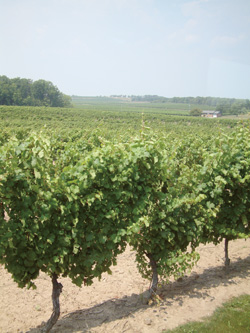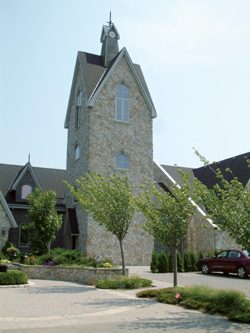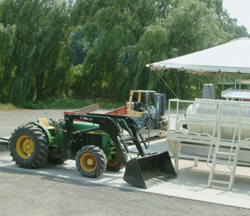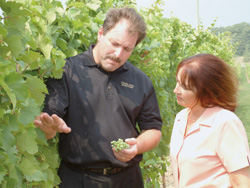
Features
Fruit
Production
It’s what’s on the outside of the bottle that counts
of the bottle that counts
March 31, 2008 By Marg Land
Drive down the Niagara QEW these
days and you’ll probably see more signs advertising and directing you
to wineries than ones informing you of the legal highway speed or where
you’re going.
 Visit to Niagara winery about more than wine
Visit to Niagara winery about more than wine
Drive down the Niagara QEW these days and you’ll probably see more signs advertising and directing you to wineries than ones informing you of the legal highway speed or where you’re going.
It’s part of a trend that has been growing in the Niagara region and in Ontario’s newest grape growing region, Prince Edward County – namely the on-farm winery. But opening a winery doesn’t seem to be enough these days – it has to be an entertainment experience.
“People don’t put on their blinker on the QEW just to buy a cheap bottle of wine,” says Allan Schmidt, president of Vineland Estates Winery, located on the escarpment bench south of the town of Vineland. “It’s more about what’s on the outside of the bottle than on the inside.”
 Vineland Estates has been producing wine grapes since 1979 and opened its winery in the 1980s (its first vintage was released in 1983). But over time, the operation has become more than a place to buy wine; it’s become an entertainment destination. Schmidt explains that management realized they needed to develop an agri-tourism component and add value to the winery.
Vineland Estates has been producing wine grapes since 1979 and opened its winery in the 1980s (its first vintage was released in 1983). But over time, the operation has become more than a place to buy wine; it’s become an entertainment destination. Schmidt explains that management realized they needed to develop an agri-tourism component and add value to the winery.
So, they started working with what they had, converting the Mennonite farm’s original 1845 home into a restaurant that can seat 140 people with a menu that features locally-grown produce and cuisine. An old carriage house has been converted into an elegant gathering room used for weddings, reunions or business conferences and a flat piece of land adjacent to the building is used as a helicopter-landing pad for high-ranking executives using the facility. A bed and breakfast cottage is also available and the farm’s original barn has been renovated into a wine boutique featuring hand-blown glass, high-quality kitchenware and, of course, the farm’s extensive wine list.
 But with development has also come logistical headaches. Being outside of the urban centre also means being beyond the reach of urban infrastructures, such as water and sewage lines. With steadily increasing numbers of people coming out to the winery, management was faced with how to deal with the washroom and water needs of those visitors. So, they decided to create a sewage treatment facility on-site. Now, 15,000 litres of wastewater and sewage are treated each day at the winery through a wetland biofilter system. There are four “cells” located on the farm where the wastewater is pumped and filtered. After two days, “it comes out as crystal clear water with no bacteria,” explains Schmidt, adding that the recycled water is then used for irrigation purposes, freeing up well water for human consumption.
But with development has also come logistical headaches. Being outside of the urban centre also means being beyond the reach of urban infrastructures, such as water and sewage lines. With steadily increasing numbers of people coming out to the winery, management was faced with how to deal with the washroom and water needs of those visitors. So, they decided to create a sewage treatment facility on-site. Now, 15,000 litres of wastewater and sewage are treated each day at the winery through a wetland biofilter system. There are four “cells” located on the farm where the wastewater is pumped and filtered. After two days, “it comes out as crystal clear water with no bacteria,” explains Schmidt, adding that the recycled water is then used for irrigation purposes, freeing up well water for human consumption.
On the production side of things, Vineland Estates does all of its crushing outside under a canopy adjacent to the operation’s extensive vat system. All choice grapes meant for premium reserve varieties are handpicked while the rest of the crop is machine harvested. Vineland Estates is considered a medium-sized winery, producing about 50,000 cases of wine per year.
In order to protect delicate vines from southern Ontario’s intermittent cold winter temperatures, Vineland Estates buries some of its less cold-tolerant varieties, including sangiovese and shiraz (syrah). Even with these protective measures, the past two winters have resulted in bud death on some vinifera vines, ultimately limiting the number of grapes available. This happened despite the terrace’s funnelling affect, which helps move cold air down the escarpment, resulting in less cold damage than in other areas.
“We just don’t have enough wine this year,” explains Schmidt, adding that winery management is considering putting up wind machines to help protect the tender grape buds on cold nights. In some cases, the winery has been forced to cut volume to some of its export customers.
 |
| Vineland Estates president Allan Schmidt with Ontario Agriculture Minister Leona Dombrowsky |
The majority of wine produced at Vineland Estates is either sold through the on-farm wine boutique, purchased off the restaurant wine list, marketed through the winery’s home delivery service, wholesaled, exported to the U.S. and 15 other countries around the world (including most of its ice wine to Japan) or shipped within Canada to B.C., Alberta, Manitoba, and Quebec. Vineland Estates only lists two of its wines through the Liquor Control Board of Ontario (LCBO).
“If you live in Hong Kong, you stand a better chance of getting our wines than if you lived in Toronto,” Schmidt says. “It’s hard for the LCBO to respond to 12 new wineries opening each year with 10 wines each. That’s why we need alternative routes of marketing available.”
He explains that for each litre of wine produced at Vineland Estates, it costs between two and three dollars to grow the grapes and an additional $1.80 to process them into wine.
“When we sell through the LCBO, we get three dollars back,” Schmidt says. “That doesn’t even cover the cost of production.”
Despite these market limitations, Vineland Estates continues to produce high-quality wines, recently winning the top award at VinItaly 2003, the Premio Speciale Grand VinItaly 2003 award, and becoming the first Canadian winery to win the distinguished prize.
Print this page